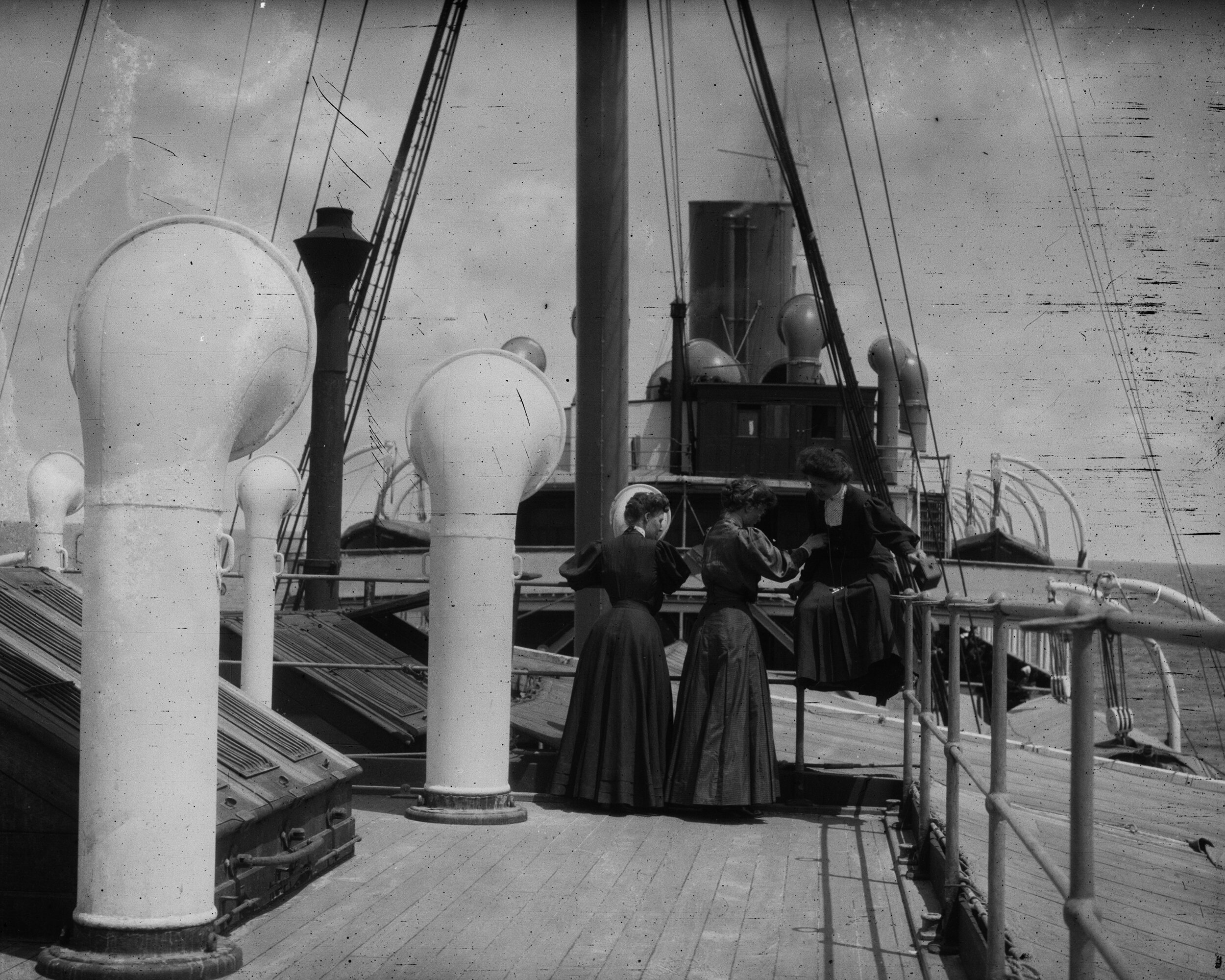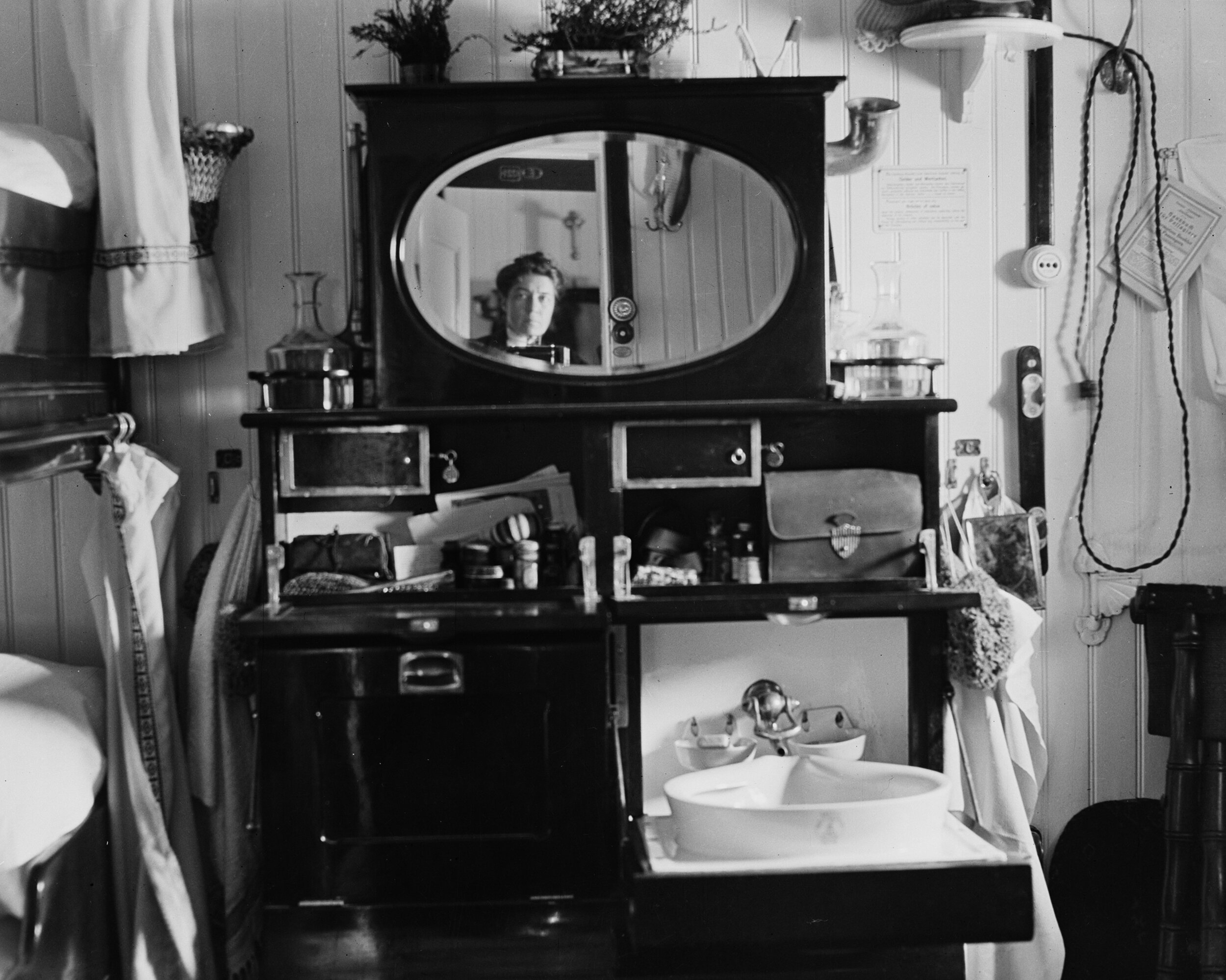Alice Austen: Life with Gertrude Tate
Miss Alice Austen and Staten Island’s Gilded Age
by Bonnie Yochelson
Life with
Gertrude Tate
In 1897, Alice met Gertrude Tate while on vacation in the Catskills. Although Gertrude lived with her mother and sister in Brooklyn, the two women became inseparable. In 1917, Gertrude moved to Clear Comfort, where they lived contentedly until 1929, when Alice lost her savings in the stock market crash. They struggled in vain to maintain their way of life, and in 1945 they were forced to move out.
[Alice Austen and Gertrude Tate in the Catskills], 1897, Collection of Historic Richmond Town, 50.015.7530.021
Accompanying the Ecclestons to the Twilight Park resort in the Catskills, Alice befriended Gertrude Tate. Alice was 31, and Gertrude, a dancing instructor, was 26. Recovering from an illness, Gertrude had lost her hair and wore a wig, but her condition did not stop her from enjoying herself, as these photographs show. (Gertrude wears a white shirt and dark skirt, Alice a tan, wide-brimmed hat.)
[Alice Austen and Gertrude Tate in the Catskills], 1897, Collection of Historic Richmond Town, 50.015.7530.020
After Alice left the resort, Trude Eccleston wrote to her about Gertrude, whom they had nicknamed, “the Chipmunk”:
Hardly any one will be left here after Labor day— the Tates go then. I will miss them so much, we must keep track of the Chipmunk, she is a great girl. She sends lots of love to you & says she misses you more than she can say.
Alice made several photo albums commemorating this vacation, one of which she inscribed to Gertrude: “G.A.T.—Twilight Park—Summer 1897—E.A.A.”
[Gertrude Tate portrait], n.d., Collection of Historic Richmond Town, 50.015.7178
Locust Tree on our Terrace, ca. 1905, Collection of Historic Richmond Town, 50.015.5525
Gertrude became a regular visitor to Clear Comfort. For this full-length portrait, which captures her relaxed grace, Gertrude posed in the same corner of the piazza with the same props that Alice had used in 1892 to photograph herself, Trude, and Julia Bredt.
In this masterful composition, Gertrude’s pose with hand on hip echoes the contours of a majestic locust tree on the terrace of Clear Comfort.
[Auto ride to Center Port], April 23, 1910, Collection of Historic Richmond Town, 50.015.5021
Alice loved automobiles and was an early Staten Island auto owner. She and Gertrude often went driving with their friend, Guy Loomis, a bachelor and heir to a Brooklyn lumber fortune. On a cold spring day, Alice got out of the car to document their journey to Long Island.
Between 1903 and 1912, Alice and Gertrude traveled to Europe for several months almost every summer. For transcontinental travel, she packed film rather than glass negatives. Among Alice’s many unremarkable tourist photographs are some lovely scenes including Gertrude. Especially noteworthy is a 1912 photograph of the interior of their cabin on the S.S. Cleveland, which can be read as a portrait of their relationship.
[Box Tree Tea Room, Perine House] 1922, Collection of Historic Richmond Town, 50.015.7126
In 1917, shortly before Aunt Minn died, Gertrude moved to Clear Comfort. In the late 1910s and early 1920s, Alice and Gertrude ran the Box Tree Tea Room for the benefit of the Perine House, a 17th-century house even older than the Austen House, where the Staten Island Antiquarian Society and the Staten Island Garden Club held their meetings.
The 8 x 10 inch glass negative of the tea room stands apart from most of Alice’s photographs of the 1920s and 1930s, which were 4 x 5 film negatives. Alice’s darkroom was not set up to process film, and most of her film negatives were never printed. When she wanted prints, she took the negatives to a commercial printer. In her later years, the camera remained an integral part of Alice’s everyday life, but she was no longer motivated by social ambition to make beautiful prints.
Children dancing waltz at Woman's Club, n.d., Collection of Historic Richmond Town, 50.015.7167
Alice lost her savings in the 1929 stock market crash, and she and Gertrude struggled to maintain Clear Comfort throughout the Depression. In her seventies, Gertrude returned to teaching dance and deportment to earn much-needed income. In this photograph, Gertrude partners one of her students in the back of the classroom.
[Alice Austen and friends], n.d., Collection of Historic Richmond Town, 50.015.2792
Alice documented a reunion of her childhood friends at Clear Comfort, probably taken in the 1920s when they were in their sixties. Seated on the steps of the piazza are Alice (front right), Trude Eccleston Barton (rear right), Julia Marsh Lord (front left), and two other friends. By then, Trude and Julia had left Staten Island and were living in New Jersey. It may be that Gertrude Tate stood behind the camera to release the shutter.
In the 1920s, Alice rejected several offers of $100,000 or more for Clear Comfort, which was zoned for commercial use. This 1930 photograph, which contrasts the rustic gate of Clear Comfort with the nearby Wrigley’s chewing gum factory, poignantly captures the transformation of Clifton that Alice was loath to accept. By 1944, when Alice was forced to sell the house, the property had been rezoned for non-commercial use and sold to a local tavern owner for a mere $7,500.
Our gate from inside, March 24, 1930, Collection of Historic Richmond Town, 50.015.2703
That year, a hurricane downed a tree on the back of the house and left it nearly uninhabitable. Soon after, Alice and Gertrude moved to the Wisteria Apartments in St. George, and by 1949, Alice’s arthritis had become so severe that Gertrude could no longer care for her. In 1950, Alice moved to the New York City Farm Colony in Castleton, Staten Island, for the indigent poor. Gertrude moved into her sister’s home in Queens.

![[Alice Austen and Gertrude Tate in the Catskills], 1897, Collection of Historic Richmond Town, 50.015.7530.021](https://images.squarespace-cdn.com/content/v1/5d23a00f53f6300001f811bb/1630208461676-CCETOLD8UGEI00OISQ2J/500157530021-large_aa_gray-c.jpg)
![[Alice Austen and Gertrude Tate in the Catskills], 1897, Collection of Historic Richmond Town, 50.015.7530.020](https://images.squarespace-cdn.com/content/v1/5d23a00f53f6300001f811bb/1630208491151-G0XLQILZ5JAZ0U3WT0XX/500157530020-large_aa_gray-c.jpg)
![[Gertrude Tate portrait], n.d., Collection of Historic Richmond Town, 50.015.7178](https://images.squarespace-cdn.com/content/v1/5d23a00f53f6300001f811bb/1628775567112-1SEU41EVP9QX8046YOI1/50.015.7178_aa.jpg)


![[Alice Austen and Gertrude Tate in a rowboat, The Trossachs, Scotland] 1903 Collection of Historic Richmond Town, 50.015.3562](https://images.squarespace-cdn.com/content/v1/5d23a00f53f6300001f811bb/1630208583815-C79I6A0QUTF25021G5L2/50.015.3562_aa_slide-1-c.jpg)
![[Gertrude Tate and a friend in front of the Paris Opera], September 16, 1905 Collection of Historic Richmond Town, 50.015.3595](https://images.squarespace-cdn.com/content/v1/5d23a00f53f6300001f811bb/1630208612250-VZ40R8PKLDD33YVRD8B2/50.015.3595_aa_slide-2-c.jpg)


![[Box Tree Tea Room, Perine House] 1922, Collection of Historic Richmond Town, 50.015.7126](https://images.squarespace-cdn.com/content/v1/5d23a00f53f6300001f811bb/1628776060671-G2O0N9GMONFB0F88V1MY/50.015.7126_aa.jpg)

![[Alice Austen and friends], n.d., Collection of Historic Richmond Town, 50.015.2792](https://images.squarespace-cdn.com/content/v1/5d23a00f53f6300001f811bb/1630208738417-4EOC4UGAJBXZV6FYKR4G/50.015.2792_aa-c.jpg)
